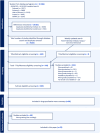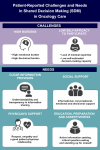From Burden to Empowerment. Patient-Reported Influencing Factors on Participation in Shared Decision Making in Oncology, a Meta-Study
- PMID: 40660710
- PMCID: PMC12260273
- DOI: 10.1002/pon.70218
From Burden to Empowerment. Patient-Reported Influencing Factors on Participation in Shared Decision Making in Oncology, a Meta-Study
Abstract
Objective: We aim to provide a literature overview on patient-reported barriers and facilitators to participation in Shared Decision Making (SDM) within the setting of oncology.
Methodology: Within the set of selected studies for a larger qualitative meta-summary, using five databases, we selected the studies that had surveyed patients with oncologic illness for further analysis in this paper. Search terms were based on the concepts: 'decision making', 'patient participation', 'patient perceptions' and 'study design' aimed at eliciting patients' perspective, including patient surveys, interviews and focus groups.
Results: Out of the 90 studies that had been selected for the larger review, we selected 22 articles concerning oncologic illness for more detailed analysis in this review. In total, we identified 33 different barriers and facilitators. Based on the most frequently reported barriers and facilitators, we defined six broad analytical themes, reflecting patients' most frequently recurring challenges (Themes 1 and 2) and needs (Themes 3-6) in this setting: (1) 'High burdens', (2) 'Low self-efficacy to participate', (3) 'Clear information provision', (4) 'Social support', (5) 'Physicians' support', (6) 'Education, preparation and assertiveness'.
Conclusion: The high decisional and emotional burdens oncologic patients experience appear to be specific challenges to SDM in oncology, which often undermine patients' self-efficacy to participate and complicate patients' engagement in SDM. However, when offered the right support, patients may overcome the existing burdens and become more empowered to engage in SDM.
Practice implications: These insights need to be integrated in SDM strategies so that they may serve the ethical imperative of greater equality and the inclusion of diverse patient groups in different SDM settings.
© 2025 The Author(s). Psycho‐Oncology published by John Wiley & Sons Ltd.
Conflict of interest statement
The authors declare no conflicts of interest.
Figures
Similar articles
-
Can We Enhance Shared Decision-making for Periacetabular Osteotomy Surgery? A Qualitative Study of Patient Experiences.Clin Orthop Relat Res. 2025 Jan 1;483(1):120-136. doi: 10.1097/CORR.0000000000003198. Epub 2024 Jul 23. Clin Orthop Relat Res. 2025. PMID: 39051876
-
Interventions for improving the adoption of shared decision making by healthcare professionals.Cochrane Database Syst Rev. 2010 May 12;(5):CD006732. doi: 10.1002/14651858.CD006732.pub2. Cochrane Database Syst Rev. 2010. Update in: Cochrane Database Syst Rev. 2014 Sep 15;(9):CD006732. doi: 10.1002/14651858.CD006732.pub3. PMID: 20464744 Updated.
-
Examining How Technology Supports Shared Decision-Making in Oncology Consultations: Qualitative Thematic Analysis.JMIR Cancer. 2025 Jun 11;11:e70827. doi: 10.2196/70827. JMIR Cancer. 2025. PMID: 40499161 Free PMC article.
-
How lived experiences of illness trajectories, burdens of treatment, and social inequalities shape service user and caregiver participation in health and social care: a theory-informed qualitative evidence synthesis.Health Soc Care Deliv Res. 2025 Jun;13(24):1-120. doi: 10.3310/HGTQ8159. Health Soc Care Deliv Res. 2025. PMID: 40548558
-
Shared decision-making for people with asthma.Cochrane Database Syst Rev. 2017 Oct 3;10(10):CD012330. doi: 10.1002/14651858.CD012330.pub2. Cochrane Database Syst Rev. 2017. PMID: 28972652 Free PMC article.
References
-
- Crossing the Quality Chasm . A New Health System for the 21st Century. Institute of Medicine (US) Committee on Quality of Health Care in America (National Academies Press (US), 2001). - PubMed
-
- Elwyn G., Tilburt J. M. V., and Montori V., “The Ethical Imperative for Shared Decision‐Making,” European Journal for Person Centered Healthcare 1 (2013): 129–131, 10.5750/ejpch.v1i1.645. - DOI
Publication types
MeSH terms
Grants and funding
LinkOut - more resources
Full Text Sources
Medical



